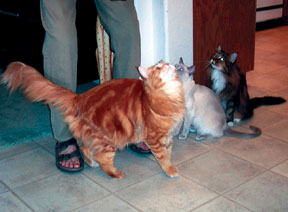
288
The teakettle begins to whistle, a signal that your cup of tea is only moments away. As you make your way to the kitchen, your cat, Buster, runs in front of you as if to say, Hey, its time for my treat, too! Fortunately, you see him in time to avoid tripping over him or stepping on him. Like many cats, Buster gets your attention by being underfoot.
Cats who are frequently underfoot come in all shapes, sizes and ages, and they may have a variety of motives. If you have a kitten, youll find him in your path more often than not because kittens spend a great deal of time chasing and playing and lack awareness of the possibility of being stepped on.
But an older cat can weave his way around your ankles or run in front of you as often as a kitten might. If it works, theyll do it, says Michele Bamberger, DVM, owner of Veterinary Behavior Consultants and a visiting fellow in animal behavior services at Cornell Universitys College of Veterinary Medicine. It can be a cat of any age.
A Good Way to Get Your Attention
Cats dont intentionally trip their owners, but winding their way between your legs or running in front of you is an effective way to make you stop and notice them. Your cat isnt tall enough to tap on your arm, unless you are seated, and sometimes a simple meow doesnt do the trick. Many cats are simply looking for attention, says Dr. Bamberger.
Wanting to be fed, wanting to play or simply wanting their owners to stop and pet them are some of the reasons why cats may be underfoot or weaving between your legs, even when you are standing still. You may find your cat especially forceful when its time to eat or when you first come home. Some cats might do this under certain circumstances connected with separation anxiety, says Dr. Bamberger, but they will exhibit other signs as well, like vocalization.
Having a cat underfoot presents potential hazards. Tripping or dropping things, especially if you are cooking, can injure you or your cat. If an older person falls, it can be serious, says Dr. Bamberger. And if you fall or step on the cat, you can damage the cat, especially if its small.
Reinforce the Positive
If you are like most cat owners, your cat running under your feet elicits a response. Even if the response is negative, it reinforces the cats behavior. Most people would pick up the cat or give the cat attention, says Dr. Bamberger, which is not going to stop the behavior and it actually encourages the cat to do it again.
If running underfoot doesnt pay off for your cat, she will find another way to get your attention.
When your cat winds around your legs or runs in front of you, the best approach is to stand still and be silent. Wait a few seconds and then step to the side, says Dr. Bamberger. Ignore your cat by standing still and let her realize she wont get your attention this way.
You can prevent the behavior by using some training techniques that employ positive reinforcement. Clicker-training your cat to obey commands such as sit or stay will give you ammunition to use if she attempts to corral you with her body. Clicker training uses positive reinforcement techniques and a small clicking device to accustom animals to understanding and obeying commands. Its best used before the behavior starts, says Dr. Bamberger. If your cat knows sit or stay, she cant be winding around your feet.
Other methods Dr. Bamberger recommends are distraction techniques such as shaking a can of pennies or using an air canister. Stay away from aversive techniques like squirt bottles, she says. Throw a ball to distract her.
Separation Anxiety in Cats
Separation anxiety doesnt just affect your pooch. Cats get it as well, and the signs are similar: inappropriate elimination, vocalization, and destruction when the owner is away or out of sight. Some cats may attempt to prevent their owners from leaving by being underfoot or by nipping at their ankles. To discourage this behavior, Dr. Bamberger suggests several simple measures.
(1) Ignore your cat completely for 20 minutes before leaving and after returning home.
(2) When you do leave, keep your exits and departures low key and casual.
(3) Be sure that your cat has enough to do while you are gone in the form of safe toys and hunting for small bits of food that you have hidden around the house.
(4) Habituate your cat to your leaving by preparing to leave and then remaining home instead.
(5) Never punish your cat for misbehaving while you were away.



